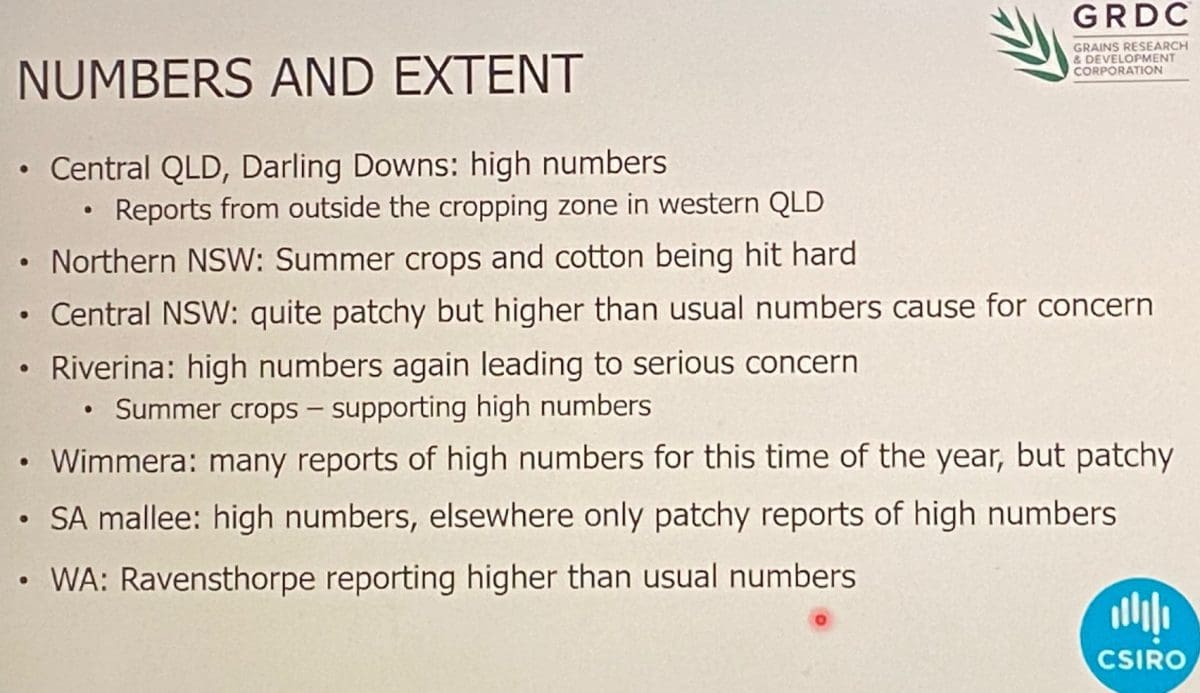FARMERS battling to contain a widespread mouse outbreak throughout eastern Australia are doubling down on efforts to mitigate damage to maturing summer crops and head off the threat to the forthcoming winter crop sowing.
 Highlighting the level of concern, more than 500 people tuned into a GRDC-run mouse update webinar this morning that homed in on techniques to address the problem.
Highlighting the level of concern, more than 500 people tuned into a GRDC-run mouse update webinar this morning that homed in on techniques to address the problem.
CSIRO research officer and mice control expert, Steve Henry, said farmers needed to constantly monitor their crops and stubbles for mouse activity, reduce the residual food available to the pests and do what they could to maximise the effectiveness of their baiting programs.
Reduce alternative food
Mr Henry said the key to running a successful baiting program was to minimise the amount of alternative food available to the mice.
He said mice needed 3 grams of food per day to survive. There are about 22 grains in a gram, so a mouse needs 66 grains/day. If harvest loss is 1 tonne/ha that equates to 2200 grains/square metre.
“It is really important to reduce food to make the environment in stubbles unfriendly for mice,” he said.
“If you can use sheep to reduce food, that is a great way to make an unfriendly environment for mice.
“With grain on the ground and summer rainfall, spraying out the germinations helps take a lot of food out of the system.”
Mr Henry said reducing residual food was critically important because, if there was alternative food available, mice might only eat a small portion of baited grain and receive only a sublethal dose, then transition back to an alternative food.
“The problem with that is once mice get a sublethal dose they stop eating the bait. If you increase the chances of them being hungry and encountering the bait you will get a much better result for your baiting effort,” he said.
Baiting ahead of winter crop
Mr Henry said in the lead up to winter crop sowing growers needed to be patient and wait until about six weeks ahead of sowing before applying the main bait for mouse control – zinc-oxide-coated grain.
“If you think you have a mouse problem at that point apply bait, then continue to monitor for the six weeks between the first application and sowing. If you still think you have mice at sowing, put bait out straight off the back of the seeder because we know most of the damage happens in the first 24 to 48 hours after the crop is sown,” he said.
“The advantage of putting it out off the back of the seeder is you don’t have to make a second pass.
“Also, if you are sowing with knives, you get some soil throw that buries a lot of the residual food in the system. As you put the bait out, that falls on top of the freshly tilled soil. The bait is the first thing the mice find. It gives you the best chance of getting a good result.”
Summer crop damage
While some farmers were not having a lot of success controlling mice in summer crops, Mr Henry said the only real option was for them to persist with baiting.
“Applications of bait now under sorghum crops are going to give you the best chance of controlling mice,” he said.
“The advantage of making sure the bait gets on the ground now is that it is less risky for a mouse to pick up a bait of the ground than it is to climb a stem which puts them at risk of predation.
“If you have baited and the mice are still hammering your crop, you just have to go again.”
Mixing with other inputs
Mr Henry strongly advised growers against mixing mouse bait with other inputs such as fertiliser or bait for slugs and snails.
“There are significant problems with mixing bait with other mediums,” he said.
“For instance, if you were to put it into urea, as it is being agitated with the urea the zinc phosphide is being scraped off the surface of the grain. Because you are scraping zinc phosphide off the grain you are increasing the chance of the mice getting a sublethal dose, causing aversion.
“The second problem is you are putting it out with urea, so there are two new things going into the paddock. If the urea tastes bad for mice they will not eat the new bait either but will go back to what they were eating before.”
Area-wide cooperation
Mr Henry said the wider the area that could be covered in a baiting program, the more effective that program would be.
“If you just bait one paddock on your farm and take all the mice out, you can be sure that within a small period of time others will come in and fill that niche,” he said.
Likewise, he said if farmers could co-ordinate with neighbours to bait at the same time, that would reduce the chance of creating a ‘sink’ where mice had been cleared from an area, only to have it reinfested by mice from surrounding areas.

Grain Central: Get our free cropping news straight to your inbox – Click here

HAVE YOUR SAY